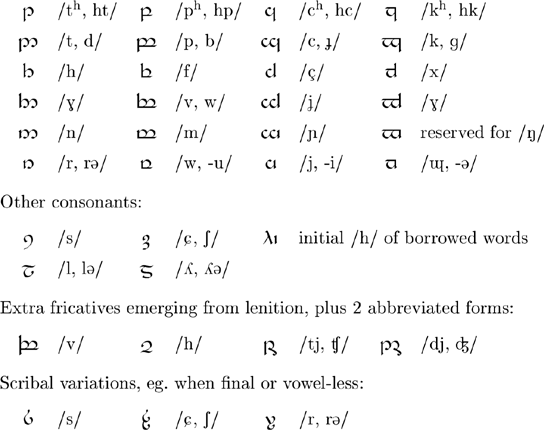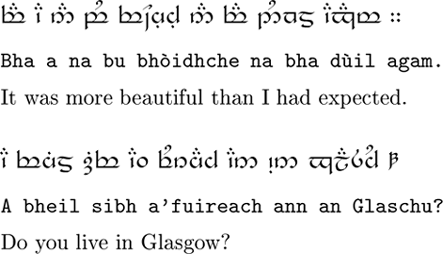This method of writing Scottish Gaelic was devised by Ian James. He believes one of the challenges facing a language which is struggling against extinction is making it attractive to learn. On the face of it, Gaelic is a beautiful language to hear and speak, but frightful to read and spell. Some would say the quaintness of unusual letter combinations is part of Gaelic's charm; others would wonder why Latin letters - the basis of English and Romance languages - have been adhered to at all, given its accompanying complexity and the lack of apparent relationship to the phonemics of those other Latin-based scripts.
Tengwar is the script devised by J.R.R. Tolkien for writing an Elvish tongue, as explained in Appendix E of 'Lord of the Rings'. Using a popular 'elvish' script (with slight modification) for Gaelic is somewhat appropriate, given the strong connection in traditional lore through the Old Irish ancestry to the otherworldly Tuatha De Danann. It also resembles slightly the uncial alphabet of medieval Celtic manuscripts, or an historical sideways development of it.
Adapting this then to the /phonetic/ form of the living language, rather than directly substituting for the highly evolved (though unusual) use of Latin letters, should make it seem apt and natural. In addition, this use of a fictitious, lighthearted and beautiful script for the fading Gaelic tongue may both help to lighten the somewhat gloom-ridden topic of Scottish cultural survival, and encourage young people and foreigners to explore the language.
Almost all of the 4 consonant series (Elvish tema) are used, and fit Tolkien's original scheme comfortably. In turn, these series were clearly inspired by the Brahmi-Sanskrit arrangement.

Note that the /k/ series has slender forms in the /c/ series, with /n/ also having its slender form there; and /s/ and /l/ have their own slender forms. Others will use a following or preceding semivowel /j/ to achieve the palatizing effect, if the slender vowels /e/ and /i/ are not able to by themselves. The singular forms of /tj/ and /dj/ are simply abbreviations for /t/+/j/ and /d/+/j/. The spelling rule of 'slender to slender, broad to broad' no longer applies, since we are just writing the sounds.
Lenition is the grammatical change of initial consonants; in almost all cases, it involves a simple swapping of the vertical stem, showing a change to the fricative of the consonant series. This also shows where fricatives in general have come from:

There is equivalence of sound in the pairs 'th/sh' and 'dh/gh' and 'bh/mh' but their written forms distinguish the phonological or grammatical derivation of the phoneme. This goes a little way toward preserving historical roots, where the use of a phonetic method will generally obscure them. It may be noted that in Old Irish, 'th' 'dh' 'bh' would have been unvoiced dental fricative, voiced dental fricative and voiced bilabial fricative respectively, which makes even more sense of the consonant series.
Vowel marks (Elvish tehtar) are written above their preceding consonant, in the Quenya style of diacritic placement. This system is similar to those used in scripts of the far eastern branches of the Indo-European language family; Gaelic is the farthest west of this family. If initial and/or long, vowels sit above a carrier; for diphthongs, a semivowel follows. Optional forms of some vowels are available, for avoiding top stems, etc.

NB. There are no silent letters except lenited /f/ and the elison-marker.
Numerals are stylistically related to the letters, and were designed in sets of three, with optional forms for 10, 11 and 12. Elvish numbers were formed with digits going right to left, as in the Arabic language; but that might prove confusing.
![]()


Differences in spelling by Tengwar may occur where dialects differ. There would seem no reason to discourage this, since it merely preserves the local speech, and would be no less intelligible than the hearing of them.
Comments on this system may be sent to ianrjames at hotmail dot com.
Tengwar pages: Tengwar for Quenya, Sindarin, Arabic, English, Finnish, High Valyrian, Hungarian, Icelandic, Kurdish, Portugese, Russian, Scottish Gaelic (1), Scottish Gaelic (2), Spanish, Spanish (Latin American), Turkish, Vietnamese, Welsh
Tolkien's alphabets and languages: Cirth | Sarati | Tengwar for Quenya | Tengwar for Sindarin | Uruk Runes | Links | Books about Tolkien's languages | Tolkien's books
Constructed scripts for: Ainu | Arabic | Chinese languages | Dutch | English | Hawaiian | Hungarian | Japanese | Korean | Lingala | Malay & Indonesian | Persian | Tagalog / Filipino | Russian | Sanskrit | Spanish | Taino | Turkish | Vietnamese | Welsh | Other natural languages | Colour-based scripts | Tactile scripts | Phonetic/universal scripts | Constructed scripts for constructed languages | Adaptations of existing alphabets | Fictional alphabets | Magical alphabets | A-Z index | How to submit a constructed script
Akkhara Muni, Amethyst, Bostani, Elektrum, Fontok, Klaekson-Zaen, Maui, New Akha, New Maori, New Mong, Pranish, SIGIL, Sigil Panel Script, Slinseng-Fi, Tengwar for Scottish Gaelic, Xylphika
See also: http://www.skyknowledge.com/orthographies.htm
[top]
You can support this site by Buying Me A Coffee, and if you like what you see on this page, you can use the buttons below to share it with people you know.

If you like this site and find it useful, you can support it by making a donation via PayPal or Patreon, or by contributing in other ways. Omniglot is how I make my living.
Note: all links on this site to Amazon.com, Amazon.co.uk
and Amazon.fr
are affiliate links. This means I earn a commission if you click on any of them and buy something. So by clicking on these links you can help to support this site.
[top]